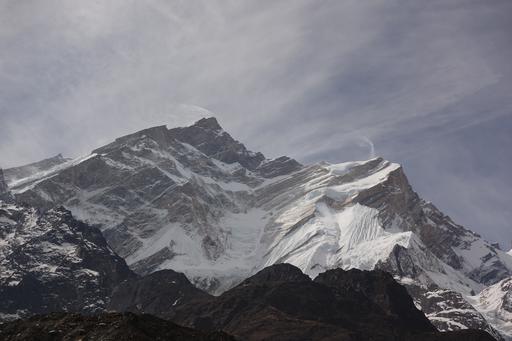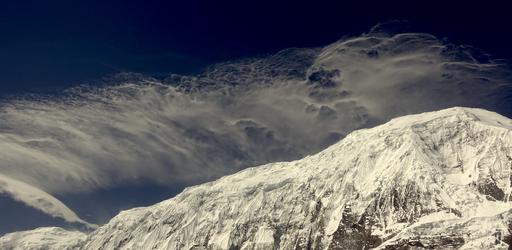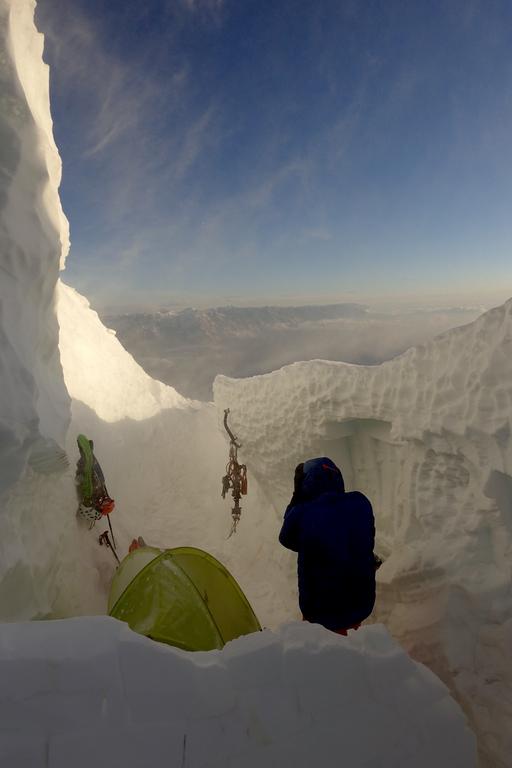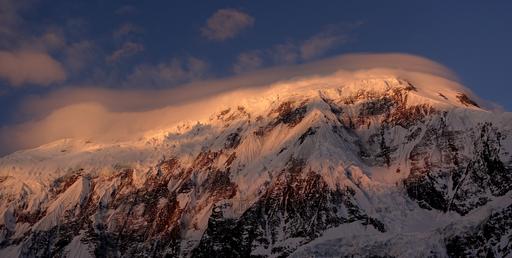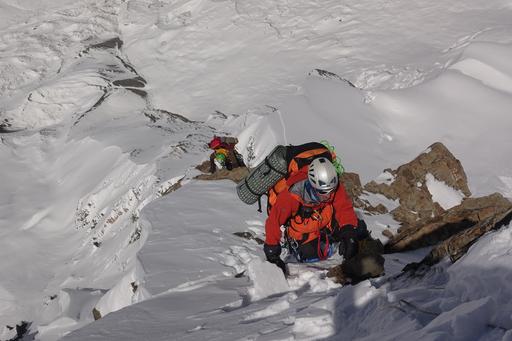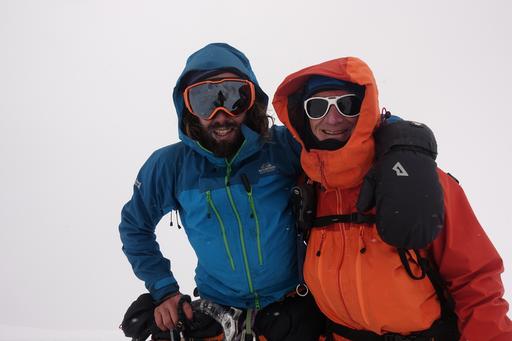Annapurna I - NW
Tilicho & Annapurna Expedition, Versuch NW-Wand 2017
In der Türkei beim Eisklettern fragte mich Adam, ob ich nicht mit auf eine 8000er Erstbegehung möchte? Ja, aber in zwei Monaten – so gut wie nicht möglich. Mit viel Biegen und Umplanen sagte ich so. Es sollte zum Cho Oyu Nordwand gehen, aber daraus wurde die Annapurna I. Hier ein englischer Bericht unserer spannenden Zeit am Berg.
Climbing Team
- Louis Rousseau
- Adam Bielecki
- Felix Berg
- Rick Allen
Annapurna I - English team report
writen by Rick Allen
Everyone would say it was a completely bad start. The advent of a disastrous adventure. Packing gear the evening before in a tornado of family and professional engagement, missing flights, missing luggage full of crucial, high altitude equipment, on top of a denied entry into Tibet because our passports contained visas from Pakistan. Our dream expedition in the highest country in the world ended before it had started. Our goal for spring 2017 was to open a new route on the almost unexplored North face of Cho Oyu but apparently some days before our arrival in Kathmandu, the Chinese introduced a new regulation barring entry to Tibet to travellers with recent Pakistani visas. As mountaineers, we had all travelled in Pakistan before, Louis had 5 pakistani visas but luckily had just received a new passport. Rick also had a visa from his ascent of the legendary Mazeno Ridge of Nanga Parbat in 2012 but that was apparently not recent enough to be a problem. Felix also had a recent visa from his 2016 attempt on Mustagh Tower but was able to secure a new travel document at very short notice from the German embassy. For Adam, with recent Pakistani visas and no Polish embassy in Kathmandu, we hit a serious problem. He would need to travel to New Dehli, itself requiring a visa, and with no guarantee of a quick turnaround, we had exhausted our options. Ultimately, it was an easy decision, climbing together was more important than any dream line. The next evening we sat in the hotel garden with our laptops, looking for a new line which would inspire us. Dhaulagiri ? – Rick had already climbed a new line in 1993 with a Russian team; Makalu? – Adam had climbed it in 2011; Lhotse or Everest ? – too crowded (!); Manaslu? – maybe some potential for a new line; Annapurna? – what about the accident statistics, it is most dangerous 8000m peak. However, what about the NW flank, steep, mixed ice, snow and rock but relatively safe? That is the one, this famous mountain, the first 8000er to be climbed has inspired a new generation of climbers to explore its mysteries and off we go with big smiles and fresh spirit and the dream of Cho Oyu fades into the background. Annapurna is the new goal, but we needed a peak on which to acclimatise if we were to achieve our aim of an true alpine style ascent of our objective. So, we looked at the map for a 7000m peak near our main goal, a gentle mountain where we can exercise our ice axes and crampons and multiply those precious red blood cells to prepare for climbing at altitude. Maybe Tilicho Peak, 7200m, with a ridge rising to 6200m and then a safe continuation to the summit snows. This was to be our preparation for Annapurna.
14 – 19 April: It was a relief to leave Kathmandu for the mountains with our new plan. We reached Bise Shahar after 10 hours of bumpy bus ride, the original starting point for the popular trek which circumnavigates the Annapurna massif. These days, the track is motorable beyond Manang and we continued by jeep, making the bumps of yesterday pale into insignificance and walking seemed like a better option. Nevertheless, we appreciated the car as time was precious for us and we could reach Humde at 3280m in one day. Finally, on the 16th we could start walking and enjoy the mountains around us. After 7 hours, we reached the last permanent settlement of the valley, Kangsar at 3735m. The next day, we gained another 400m and spent the night at the Tilicho Base Camp Lodge which was to be our home for the next two nights. One the 18th we walked up to Tilicho Lake, which the locals call the highest lake in the world, now completely ice covered. From here, we had a good view of our first goal, Tilicho Peak and admitted it was quite impressive, dominating the NW skyline. The next day, we left the comfort of the lodge and set out to reach the far end of the lake to establish our true base camp for the next 10 -12 days. Thinking of ourselves as strong climbers, we underestimated how hard, regular trekking in Nepal can be as it took a lot of effort to cross the Eastern Tilicho pass at 5340m with heavy packs in worsening weather. Finally, after 8 hours we reached a fine spot by the Northern end of the lake, close to the foot of our intended objective. We have huge respect for our porters, who crossed the pass with heavier loads. We may be well equipped and technically skilled but we shall never be as tough as they are. 20th April was a resting and organising day at our minimal base camp comprising kitchen tent and personal tents but still it feels good to be alone in these beautiful surroundings. Ram and Janga are proving to be excellent cooks and base camp managers. On 21st April we finally did what we really came for, we went climbing. The initial steep scree and snow slopes led to the first broken, rocky pillar, which we climbed quickly without touching the old, faded and unreliable fixed rope, indicating this line had been followed by previous teams. At around one o’clock, Rick reached the ridge which was our aim for the day and searched around for a camp site. Descending around 80m, on the other side of the ridge, we were able to find a comfortable and safe site on top of a line of seracs (ice cliffs). After a relatively comfortable night, we continued up the ridge to reach a second rocky pillar, composed largely of cornflakes (Rick) or kitty litter (Louis) and Felix was comfortable to continue unroped over the last steep, icy section and was first to gain the start of the main North ridge of Tilicho Peak at about 6100m. The windy ridge was not a hospitable place for our next camp but Adam found a apparently sheltered canyon formed by a crevasse amongst the seracs. It seemed we could not have asked for a better end to a good day, but during the night, our crevasse became a wind tunnel and we battled incoming snow in our prototype high altitude tents and the effects on our bodies of a first night at 6150m. After sleepless hours and with little cooking gas left, we decided to descend, having accomplished our initial acclimatisation aims. At first, the best descent of the steep terrain we had climbed the day before was not clear but we made good use of the pitons abandoned by previous expeditions and collected thoughtfully by Louis the day before. Rappelling proved to be the best and safest way to descend and we made good progress as Adam navigated the complex terrain and efficiently set up fresh anchors. We reached base camp safe and sound in time for a late lunch, tired and happy. Sleep came easily. A day later we enjoyed restdays at a newly arrived mess tent, that finally provided a venue for playing chess.
Early on 27 April we set off up Tilicho Peak again in search of acclimatisation, and in approximately 9 hours gained our crevasse, wind-tunnel, camp site on the ridge. Most of us had a bad night and we postponed pushing further until following day. We awakened at 2.00 but the wind had gained in strength and did not relent. Finally, at 6.00 we reluctantly decided to begin the descent and were glad to reach base camp a few hours later. The following days saw repeated heavy snowfalls, totalling around a metre at base camp and we spent the time recovering and digging out our tents. The plan to acclimatise rapidly on Tilicho Peak was proving to be too optimistic. For Louis, whose available time was more limited than the rest of us, the opportunity ever to progress to the main objective on Annapurna was vanishing and on 3rd May he reluctantly descended to the village of Jomsom with the help of Adam. On 5th, Louis was able to secure a flight to Kathmandu and Adam completed the 2500m of ascent to base camp. Meanwhile, a forecasted weather window had opened and Adam moved straight on upwards the following day with Rick and Felix to the familiar crevasse at 6200m. This time, there was no hesitation, we set off at 7.00 the following morning, moving together over soft, deep snow patches and hard neve, over crevasses, through rock bands and around seracs to reach the summit of Tilicho Peak at 14.00. Satisfied with this fine, 7134m peak, we snatched some photos as clouds built and gained a glimpse of the NW face of Annapurna, our next objective. The descent took us back to our crevasse and the following day we regained base camp. In theory, we were to transfer to Annapurna N base camp by helicopter the following day, 9th May, but cloud cover was too heavy and the Kathmandu valley was shrouded in rain. The trekking route to the original base camp used by the French first ascent team in 1950 is now so dangerous for porters that all expeditions now fly into this camp. The next day was little better and Felix and Adam descended to Jomsom leaving Rick with the sirdar at base camp. As luck would have it, the following day was perfect for flying and Rick guided the little red and white helicopter into land shortly after 7.30. Meanwhile, in Jomsom, Adam and Felix recognised at once the sound of the helicopter and hurried across to the helipad. ‘Have you seen a red helicopter?’ they asked. An official tried to check their documents (they had none) while they insisted all the more strongly they needed to be on the red helicopter when it landed. Meanwhile, the red helicopter had transferred all of the expedition’s baggage to Annapurna and was taking Rick and Ram to the new base camp. Other members in Jomsom, the pilot was told. Satellite SMS messages were exchanged and the pilot agreed to pick them up. An hour later, the team was re-united under the shadow of Annapurna and a fourth flight delivered fresh food and equipment. We were finally in place. We were sharing the open slopes above the North Annaupurna glacier with small Italian, Spanish and Chilean teams who were all on the mountain, pushing for the summit via the 1950 French route. This period of low wind enabled the established teams to complete their ascents while the new arrivals could only look at the longer term forecast of strong (90kph) summit winds in frustration. When the successful pairs descended, their tales of avalanche risk and serac collapse confirmed the dangers associated with the classic route and re-affirmed our team’s choice of Tilicho Peak for acclimatisation.
We had successfully acclimatized, moved to Annapurna N base camp and now everything hinged on the weather. We were really looking for an ideal ‘weather window’ of three days of low wind at 8000m combined with little or no precipitation. Gradually, it became clear it would not be happening. We lowered our expectations and grasped at the promise of a single day of low wind followed by a day of high snow fall. We set off on Wednesday, 17th May on our pure ‘alpine style’ attempt on the NW face of Annapurna. Alpine style is often equated with light-weight style but as we shouldered our 23kg+ packs, the lightness was difficult to appreciate. Our route, paradoxically, led us first down to the glacial lakes at the foot of the N Annapurna glacier, 200m below our base camp (4100m) before climbing slowly over boulder strewn terrain leading towards the moraines below our face. The glacier is extremely fractured and we toiled over alternating rock strewn ridges and abrupt, icy slopes separating deep fissures of crevasses before emerging onto more snowy glacier in the late afternoon. Here, as the characteristic snow shower passed, we pitched our 3 person tent on a flat spot around 5000m and caught the last rays of the evening sun. An hour next morning took us to the base of a huge triangular buttress and an icy couloir running up its right hand side. We crossed the bergschrund (major crevasse) which separates the glacier from face and began to climb. This was to be the last moment for the next 3 days we had flat ground the size of six boot prints under our feet. The couloir started as a snow slope but increasingly hard icy streaks predominated at an average of about 55 degrees. It was also long, longer than we had estimated and the afternoon snow showers were well developed as we approached its top. No break in the angle provided any relief for a bivouac site so we began to cut a ledge in the ice at the foot of a rock wall where we could secure the rope. Torrents of spindrift poured intermittently down the wall and during these interludes we variously crouched or hung on, alert to the possibility that a full airborne avalanche may develop. At sunset, the snow relented once more and we had a glimpse of the sun and the Eastern flanks of Dhaulagiri. Finally, we had a ledge for half a tent and we could sit in a row, belayed inside our tent fabric with a single pole keeping it off our faces with our legs hanging free. We cooked a simple meal and brewed many hot drinks before lapsing into fitful rest. Through the tiny vent we watched a clear, starlit night develop over the central Nepal Himalaya. Getting moving in the morning was slow as we melted more snow for hot drinks, carefully unwound our safety lines which attached everything to the wall and ourselves and packed our sacks. The icy slope slanted right from the top of the couloir and we chose to rope up from the start, one climber leading and placing ice screws as the other two followed simultaneously. Whether because of the sleepless night, the effect of two days effort or the brittle, thin ice over rock, we were moving more slowly than the day before and yet again the snowfall began and we had no-where to place a tent. The descending spin drift clouds added urgency to our search and one hour before dark we tried to make something of a sloping rock ledge at 6500m. This sloped alarmingly and gathered so much snow that at the end we were hanging in our harnesses from our belay points, shrouded in tent fabric. No question of removing our boots to change into dry socks, adding warm clothing and only with the greatest efforts by Felix did we manage to melt some snow to produce a drink. By contrast, the sitting bivouac of the previous night had been luxurious. We constantly disturbed one another as we sought to shift our positions to alter the pressure of harnesses on our bodies and shivering became almost constant. When one careless movement produced a rip in the tent ( not designed to be hung exactly like this) we suddenly had a new view of the world, through the hole in floor to the glacier far below. Things deteriorated overnight as we lost one sleeping mat to the abyss and in the morning as we began to extricate ourselves from the bivouac, one sleeping bag slipped through the cellar door and disappeared. It was an open question up to this point whether we should continue upwards or descend. On the one hand, we had climbed half the face, we had confidence we could handle the technical difficulties and we ample food and gas for several more days. However, the incessant afternoon snowfall was alarming, we had slowed on the second day and after two practically sleepless nights we were not going to accelerate. From here onwards, retreat would become much more serious and breaking through to the summit ridge would require full commitment. The loss of one member’s sleeping bag tilted the argument firmly in favour of descent. Multiple nights above 6500m without a bag would be impractical, even if we could find tent sites in the steep terrain above us, which seemed unlikely. Nine hours, 20 rappels from ‘Abalakov’ ice belays and several pitches of downclimbing later, we were back on the glacier, not a little relieved and glad to pitch our wounded tent on some flat snow. As we cooked up the first meal for two days, the sound of powder snow avalanches pouring down the face confirmed our decision to descend. Another full day took us back down the glacier and its moraines to the welcoming tents of base camp. Toiling back up from the glacial lakes, as the evening sleet continued, it became clear there never really was a ‘summit weather window’.
Louis Rousseau and Adam Bielecki had conceived of a new route on Cho Oyu. They invited Rick Allen and Felix Berg to join them. Bureacratic obstacles had frustrated the original vision but a new objective had been formulated. Time constraints had taken Louis home early but Adam, Felix and Rick successfully climbed Tilicho Peak. They climbed half of the extremely serious NW face of Annapurna I before retreating in bad weather. The decision making on this kind of enterprise is crucial and most of us would say we would only contemplate such a route with someone we have climbed with extensively. Adam, Felix and Rick had never climbed together before but would gladly do so again. That is one measure of success.
